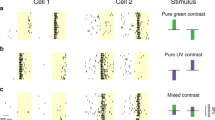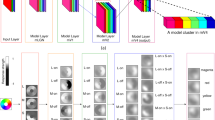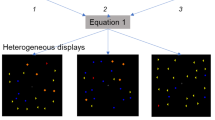Abstract
MR. WIILMER has replied1 to Prof. H. Hartridge (and incidentally to me, when I had made the same point in discussion) that the impossibility of obtaining greens and yellows by mixtures of extreme red and blue might be due to the impossibility of so obtaining high enough intensities to evoke a yellow or green sensation, rather than indicating the incorrectness of his (Mr. Willmer's) theory. Since then, the following simple and, I believe, crucial, experiment was tried.
This is a preview of subscription content, access via your institution
Access options
Subscribe to this journal
Receive 51 print issues and online access
$199.00 per year
only $3.90 per issue
Buy this article
- Purchase on Springer Link
- Instant access to full article PDF
Prices may be subject to local taxes which are calculated during checkout
Similar content being viewed by others
References
NATURE, 151, 632 (1943).
Author information
Authors and Affiliations
Rights and permissions
About this article
Cite this article
CRAIK, K. Physiology of Colour Vision. Nature 151, 727–728 (1943). https://doi.org/10.1038/151727a0
Issue Date:
DOI: https://doi.org/10.1038/151727a0
This article is cited by
-
Rods and Cones, and Thomas Young'S Theory of Colour Vision
Nature (1944)
-
Letter to Editors
Nature (1943)
Comments
By submitting a comment you agree to abide by our Terms and Community Guidelines. If you find something abusive or that does not comply with our terms or guidelines please flag it as inappropriate.



